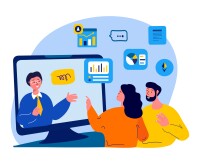Search
There are 32 results.
Category
Tag
Tag
All (32)
Active Learning (1)
Activities (2)
Assessments (2)
Canvas (2)
Case Studies (1)
Collaboration (1)
Content Creation (6)
Course Maintenance (4)
Course Materials (3)
Diversity (1)
Faculty Presence (1)
Hyperlinks (1)
Images (3)
Inclusion (1)
Infographics (1)
Learning Objectives (1)
Multimodality (1)
Page Design (1)
PowerPoint (2)
Presentations (1)
Representation (1)
Revising (2)
Rubrics (1)
Screen Readers (1)
Social Media (1)
Universal Design for Learning (UDL) (1)
Video (9)
Visual Accessibility (2)
Visual Design (1)
Case Studies in a Multimodal Course
Case-based learning allows students to develop higher-order critical thinking, problem-solving, synthesis, analysis, and communication skills by engaging with a realistic scenario in service of practicing course skills and concepts. Case studies are valuable tools for any class that combines asynchronous and synchronous learning. Indeed, some research (e.g., Webb, Gill, & Poe, 2005) suggests that a multimodal delivery model may be ideal for case study-based work, with the combination of synchronous and asynchronous elements enabling students to participate more fully in cases. In the first half of this piece, we outline some key considerations for using case studies in a multimodal course. In the second half, we make targeted recommendations for effectively prepping, facilitating, and reflecting on your multimodal case studies.
Problem-Based Learning
Problem Based Learning is a teaching method used to facilitate student knowledge acquisition. This teaching method is often confused with Project Based Learning, which centers on students applying knowledge. The focus of Problem Based Learning is students acquiring the knowledge. Since the two methods use the same acronym, they are easily confused, but have different objectives for students.
Project-Based Learning
Project-based learning is learning that is organized around a project (Bell, 2010). It is a student-centered approach to learning, where students choose their topic of study and design an integrative project around the topic (Bell, 2010; Astawa et al., 2017). This form of study promotes self-efficacy in the learning environment. Such self-efficacy enables students to perform more difficult tasks and develop confidence in their abilities (Shin, 2018). These abilities generally help students to transfer their skills to the real world.
Accessible PDFs
Developing and delivering accessible instructional content—meaning content that students with and without disabilities can readily engage with and use—is essential to the success of an online course. While many accessibility standards and guidelines are broadly applicable, there are also specific considerations unique to different content formats and delivery modes. In this piece, we present recommendations for enhancing the accessibility of PDFs for students.
Hyperlink Dos and Don'ts
When designing a course, you will want to ensure that all students can access the websites and documents that you link. Accessible hyperlinks are particularly important for students with screen readers, who will hear links read out loud. This piece contains best practices for writing and formatting accessible hyperlinks so that all learners can access the content that you have curated for your course.
Best Practices for Screencast
Do you want to deliver presentations, share tutorials, or teach complex applications in your online course? If so, creating screencasts may be a great option for you. This piece defines what a screencast is, identifies important development considerations and common instructional use cases, and highlights best practices for creating screencasts for your online course.
Self-Recording Best Practices
While traditional lectures are delivered in front of a classroom, allowing you to read students’ engagement and adjust in real time to both content and pacing, online lectures do not afford the same flexibility. Therefore, it is important to carefully plan your videos in accordance with best practices in online learning. There are many video types and formats to choose from (See the Envision blog: Matching Video Production Style to Learning Goals), and one decision you'll need to make is whether you want to appear on camera. This guide covers best practices for videos that will include your webcam footage.










